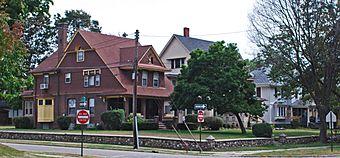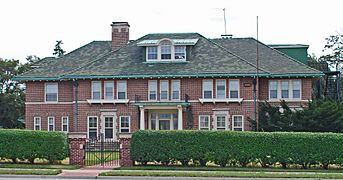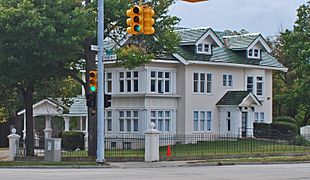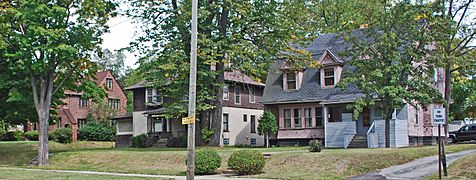Franklin Boulevard Historic District (Pontiac, Michigan) facts for kids
Quick facts for kids |
|
|
Franklin Boulevard Historic District
|
|

Corner of Franklin and Pike (Charles L. Rockwell House, 65 Franklin)
|
|
| Location | Roughly bounded by Grand Trunk Western RR, Orchard Lake Ave., Miller and W. Huron Sts., Pontiac, Michigan |
|---|---|
| Area | 36 acres (15 ha) |
| Built | 1848 |
| Architectural style | Greek Revival, Italianate, Queen Anne |
| NRHP reference No. | 83000888 |
| Added to NRHP | August 11, 1983 |
The Franklin Boulevard Historic District is a special neighborhood in Pontiac, Michigan. It's mostly filled with old houses along Franklin Boulevard, between West Huron Street and Orchard Lake Avenue. You can also find historic buildings on Mary Day and Henry Clay Avenues, and parts of West Huron and West Lawrence Streets. This entire area was officially recognized and added to the National Register of Historic Places in 1983 because of its important history and unique buildings.
Contents
Exploring Franklin Boulevard's Past
Pontiac was first settled in 1818. The earliest buildings were in the downtown area. One of the oldest buildings in the district is the Sibley-Hoyt House. It started as a small cabin and farm around 1819 or 1820.
How the Neighborhood Grew
As Pontiac grew, houses began to spread west. In 1835, George M. Williams planned out lots for homes on Lawrence and Williams Streets. Later, in 1886, Henry Clay Ward created Franklin Boulevard. He named it after his son. He also named Mary Day and Henry Clay Avenues after his wife and himself.
Houses were built in this area at different times. This means you can see many different styles of architecture.
What Makes Franklin Boulevard Special?
The main part of the district, along Franklin Boulevard, has large lots. On these lots, you'll find big, detached houses. Most of them are two or three stories tall. Even though the houses have different styles, they all sit about 60 feet back from the street. This creates a consistent and pleasing look for the neighborhood.
Houses on Side Streets
The houses on Mary Day and Henry Clay Avenues are a bit smaller. They are also built on smaller lots. However, they also share a similar look and are set back consistently from the street.
Older Homes in the East
The eastern part of the district was developed earlier. This means the houses there are generally older. Homes along West Huron Street and Williams Street are on very large lots. There's a lot of open space between them. The buildings on West Lawrence Street are usually smaller. They are one-and-a-half to two-and-a-half stories high.
Important Buildings to See
The Franklin Boulevard Historic District has many interesting and historic buildings. Here are some of the most important ones:
- Myrick-Palmer House (223 W. Huron): This house was built in 1848. It has an Italian Villa style. Frederick C. Myrick built it, and Charles H. Palmer bought it in 1862. This house is so important that it's listed on the National Register all by itself!
- Sibley-Hoyt House (146 W. Lawrence): This long, low house is one of the oldest. It started as a cabin around 1820. Another house was moved to this spot in 1867 by George Hoyt.
- First Church of Christ, Scientist (Williams and West Lawrence): This building has a Greek Revival style. It has a grand entrance with columns facing both Williams and West Lawrence Streets. It was originally a house owned by Edwin C. Smith. The church bought it around 1920.
- Pontiac Cultural Arts Center (47 Williams Street): This building was first the Pontiac City Library. It was built in 1898 by a group called the Ladies' Library Association. In 1924, they gave the library to the City of Pontiac. When the library moved in the 1950s, this building became the city's Art Center.
- Jacobs House (99 Franklin Boulevard): This is probably the oldest house on Franklin Boulevard. Banker Frank G. Jacobs built it in 1886. It's mostly in the Queen Anne style. It has a large L-shaped porch in front and two small balconies upstairs.
- McCall House (72 Franklin Boulevard): Businessman F. E. McCall built this house in 1889. It's also in the Queen Anne style. It has a cool angled bay window on one corner.
- Heltsch House (75 Mary Day Avenue): This two-and-a-half-story house is covered in clapboard siding. It has a steep roof and a porch with three decorative columns across the front.
- O. J. Beaudette House (87 Franklin Boulevard): Oliver Joseph Beaudette, who made carriages, built this house in 1914. His company was one of Pontiac's biggest employers. It later started making car bodies.
- Leo Beaudette House (269 West Huron Street): This house was built in 1917 for Oliver Leo Beaudette, Oliver Joseph's son. A famous architect from Detroit designed it. The Y.W.C.A. bought the property in 1965.
- William L. Day House (22 Franklin Boulevard): This house was built for William La Motte Day. He was a manager and president of General Motors Truck Company in Pontiac from 1912 to 1924.
- Andrew Lewis Moore House (58 Franklin Boulevard): This Queen Anne style house was built for attorney Andrew Lewis Moore between 1899 and 1902.
Gallery




